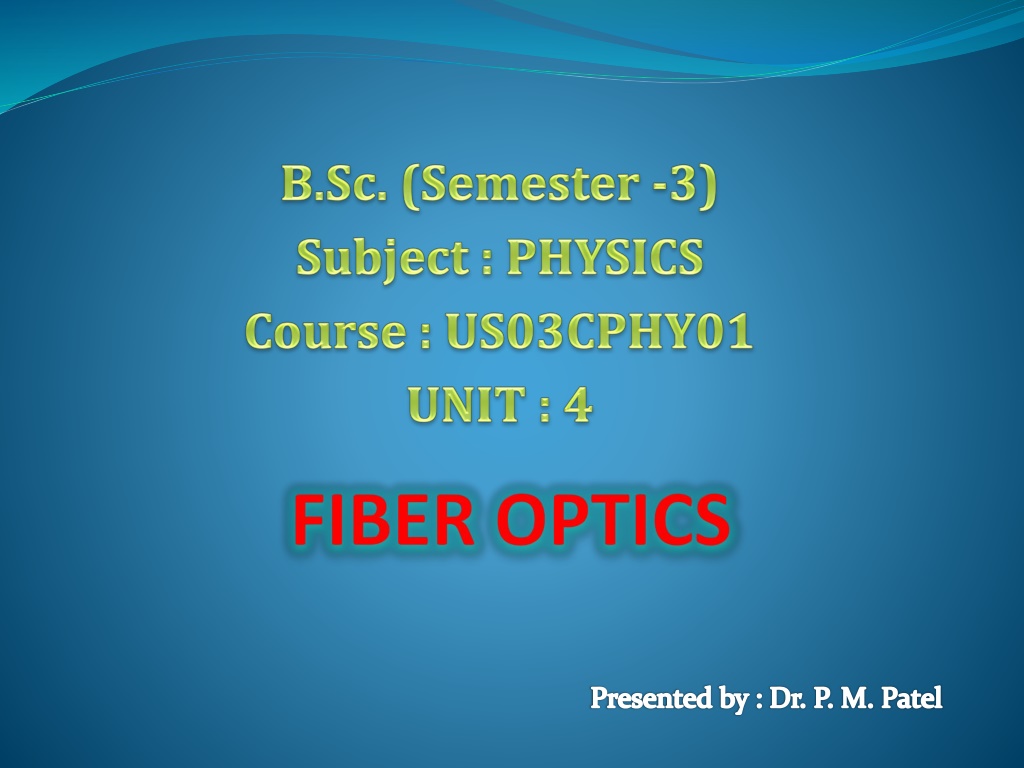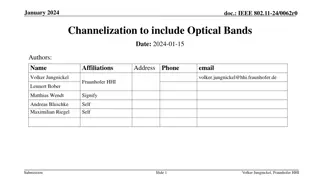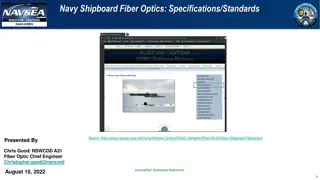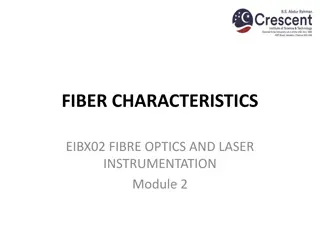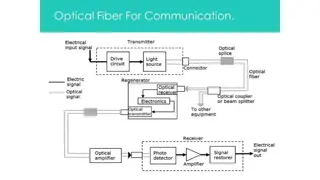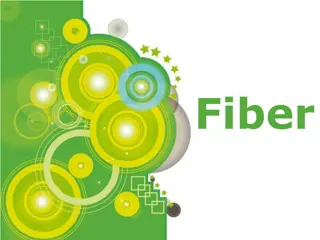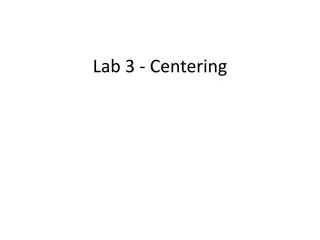Evolution of Optical Fiber Technology
Optical fiber technology has a rich history starting from John Tyndall's demonstrations in 1870 to the development of flexible fiberscopes by Hopkins and Kapany. This technology revolutionized communication systems and medical diagnostics, enabling the transmission of information through thin glass fibers via total internal reflection. Optical fibers guide light along their length, allowing for the conversion of electrical signals to optical signals and back. Today, optical fibers are widely used in commercial communication systems and various sensor applications.
Download Presentation

Please find below an Image/Link to download the presentation.
The content on the website is provided AS IS for your information and personal use only. It may not be sold, licensed, or shared on other websites without obtaining consent from the author.If you encounter any issues during the download, it is possible that the publisher has removed the file from their server.
You are allowed to download the files provided on this website for personal or commercial use, subject to the condition that they are used lawfully. All files are the property of their respective owners.
The content on the website is provided AS IS for your information and personal use only. It may not be sold, licensed, or shared on other websites without obtaining consent from the author.
E N D
Presentation Transcript
Introduction It was demonstrated by a British Physicist John Tyndall in 1870 He state that light can be guided along the curve of a stream of water. Due to this total internal reflections light gets confined to the water stream and the stream appears luminous. A luminous water stream is consider an optical fiber. In 1950s , the transmission of images through optical fibers was realized in practice.
Hopkins and Kapany developed the flexible fiberscope, which was used by the medical word and viewing the interior of human body. The Kapany has assign the term fiber optics. In 1960, it was established that light could be guided by a glass fiber. In 1966 Charles Kao and George Hockham proposed the transmission of information over glass fiber. In 1970 corning glass works produced low-loss glass fibers. The invention of solid state lasers in 1970 made optical communications practicable.
Commercial communication systems based on optical fibers are widely used in other areas. Fiber-scopes made of optical fibers are widely used in a variety of forms in medical diagnostics. Sensors for detecting electrical, mechanical, thermal energies are made using optical fibers. Fiber optics is a technology in which signals are converted from electrical to optical signals, transmitted through a thin glass fiber and reconverted into electrical signals.
Optical Fiber: Definition:An optical fiber is a cylindrical wave guide made of transparent dielectric, (glass or clear plastic), which guides light waves along its length by total internal reflection. It is very thin like human hair, approximately 70 m or 0.003 inch diameter. The thin strand of a metal is called a wire and a thin strand of dielectric materials is called a Fiber.
Principle: Light propagate in optical fiber from one of its ends to the other end is based on the principle of total internal reflection. When light enters one end of the fiber, it undergoes successive total internal reflection from side walls and travels down the length of the fiber along a zigzag path A small fraction of light may escape through sidewalls but a major fraction emerges out from the exit end of the fiber Light can travel through fiber even if it is bent.
Structure: A practical optical fiber is cylindrical in shape.
It has in general three coaxial regions Core: The innermost cylindrical region is the light guiding region known as the core. In general the diameter of the core is of the order of 8.5 m to 62.5 m Cladding: The core is surrounded by a coaxial middle region known as the cladding. The diameter of the cladding is of the order of 125 m. The refractive index of cladding ( ) is always lower than that of core (
Light launched into the core and striking the core-to-cladding interface at angle greater than critical angle will be reflected back into the core. When the angles of incidence and reflection are equal, the light will continue to rebound and propagate through the fiber.
Buffer: The outermost region is called the sheath or a protective buffer coating. It is a plastic coating given to the cladding for extra protection. This coating is applied during the manufacturing process to provide physical and environmental protection for the fiber. The buffer is elastic in nature and prevents abrasions. The coating vary in size from 250 m or 900 m.
In short Core is the inner light-carrying member Cladding is the middle layer-which serves to confine the light to the core. Buffer coating surround the cladding, which protects the fiber from physical damage and environmental effects.
Necessity for Cladding: The actual fiber is very thin and light entering a bare fiber will travel along the fibre through repeated total internal reflections at the glass-air boundary. However , bare fibers are used only in certain applications. For use in communications and some other applications, the optical fibre is provided with a cladding. The cladding maintains uniform size of the fibre, protects the walls of the fibre from chipping, and reduces the size of the cone of light that will be trapped in the fibre.
The cladding performs the following important functions: Keeps the size of the fibre constant and reduces loss of light from the core into the surrounding air. Protects the fibre from physical damage and absorbing surface contaminants Prevents leakage of light energy from the fibre through evanescent waves.
Prevents leakage of light energy from the core through frustrated total internal reflection. Reduces the core of acceptance and increases the rate of transmission of data. A solid cladding, instead of air, also makes it easier to add other protective layers over the fibre.
Optical Fibre System: An optical fibre is used to transmit light signals over long distances. It is essentially a light transmitting medium, its role being very much similar to a coaxial cable or wave guide used in microwave communications. Optical fibre requires a light source for launching light into the fibre at its input end and a photodetector to receive light at its output end. As the diameter of the fibre is very small, the light source has to be dimensionally compatible with the fibre core. Light emitting diodes and laser diodes, which are very small in size, serve as the light sources.
The electrical input signals is in general of digital form. It is converted in to optical signal by varying the current flowing through the light source. Hence , the intensity of the light emitted by the source of modulated with the input signal and the out put will be in the form of light pulses. The light pulses constitute the signal that travel through the optical fibre. At the receiver end , semiconductor photodiodes , which are very small in size , are used for detection of these light pulses. The photo detector converts the optical signal into electrical form. Thus a basic optical fibre system consists of LED /laser diode, optical fibre cable and a semiconductor photodiode.
Optical Fibre Cable: Optical fibre cables are designed in different ways to serve different applications. More protection is provided to the optical fibre by the cable which has the fibers and strength members inside an outer covering called a jacket . We study here two typical designs : 1. single fibre cable 2. multifibre cable.
Single Fibre Cable: Around the fibre a tight buffer jacket of Hytrel is used as shown in the figure.
The buffer jacket Protects the fibre from moisture and abrasion. A strength member is arranged around the buffer jacket in order to provide the necessary toughness and tensile strength. The strength may be provided by a steel wire, polymer film, nylon yarn or Kevlar yarn. Then the fibre cable is covered by a Hytrel outer jacket. Because of this arrangement fibre cable will not get damaged during bending , rolling , stretching, pulling, during transportation and installation processes. The single fibre cable is used for indoor applications.
Multifibre Cable: A multiple cable consists of number of fibers in a single jacket. Each fibre carries light independently. The cross- sectional view of a typical telecommunication cable is shown in figure 4
It contains six optical fibre strands and has an insulated steel cable at the centre for providing tensile strength. Each optical fibre strand consists of a core surrounded by a cladding, which in turn is coated with insulating jacket. The fibre are thus individually buffered and strengthened. Six insulated copper wires are distributed in the space between the fibre. They are used for electrical transmission , if required. The assembly is then fitted within a corrugated aluminum sheath, which acts as a shield. A polyethylene jacket is applied over the top.
Total Internal Reflection A medium having a lower refractive index is called rare medium while a medium having higher refractive index is known as denser medium.
when a ray of light passes from denser medium to rare medium, it is bent away from the normal in the rare medium. Snell s law is where 1 is the angle of incidence of light ray in the denser medium 2 is the angle of refraction in the rare medium .
1. If 1c , the rayrefracts into the rare medium 2. If 1 = c , the rayjust grazes the interface of rarer-to- denser media. 3. If 1 > c , the ray is refracted back into the denser medium The phenomenon in which light is totally reflected from a denser to-rare medium boundary is known as total internal reflection. The rays that experience total internal reflection obey the laws of reflection. Therefore, the critical angle can be determined from Snell s law.
When Therefore, from equation, we get when the rare medium is air , 2 =1 and writing 1 = we get
PROPAGATION OF LIGHT THROUGH AN OPTICAL FIBRE: The diameter of an optical fibre is very small We can not use bigger light sources for launching light beam into it. Light emitting diode (LFD) and LASER diodes are the optical sources used in fiber optics In case of these small sized sources, a focusing lens has to be used to concentrate the beam on to the fibre core.
Light propagate as an electromagnetic wave through an optical fibre. However, light propagation through an optical fiber can as well be understood on the basis of ray model. According to the ray model, light rays entering the fibre strike the core at different angles. As the refractive index of the cladding is less than that of the core, majority of the rays undergo total internal reflection at the interface and the angle of reflection is equal to the angle of incidence in each case.
Since each reflection is a total internal reflection There is no loss of light energy and light confines itself within the core during the propagation. Because of the negligible loss during the total internal reflections, optical fibre can carry the light waves over very long distances. Thus , the optical fibre acts essentially as wave guide and is often called a light guide or light pipe. At the exit end of the fibre, the light is received by a photo-detector.
For total internal reflection at the fibre wall following two conditions must be satisfied. 1. The refractive index of the core material n1 , must be slightly greater than that of the cladding n2. 2. At the core cladding interface, the angle of incidence between the ray and the normal to the interface must be greater than the critical angle c defined by
Critical Angles of Propagation: Consider a step index optical fibre into which light is launched at one end. The end at which light enters the fibre is called launching end.
In a step-index fibre, the refractive index changes from the core to the cladding. Now, we consider two rays entering the fibre at two different angles of incidence. The ray shown by the broken line is incident at an angle 2 with respect to the axis of the fibre. This ray undergoes refraction at point A on the interface between air and the core. The ray refracts into the fibre at an angle 1 ( 1 2).
The ray reaches the core cladding interface point at D. At point D, refraction takes place again and the ray travels in the cladding. Finally, at point E, the ray refracts once again and emerges out of fibre into the air. It means that the ray does not propagate through the fibre.
Now consider the ray shown by the solid line The ray incident at an angle undergoes refraction at point A on the interface and propagates at an angle c in the fibre. At point B on the core-cladding interface, the ray undergoes total internal reflection, since n1 > n2. Let us assume that the angle of incidence at the core- cladding interface is the critical angle c , where c is given by
A ray incident with an angle larger than c will be confined to the fibre and propagate in the fibre. A ray incident , at the core-cladding boundary, at the critical angle is called critical ray. The critical ray makes an angle c with axis of the fibre. It is obvious that rays with propagation angles larger than c will not propagate in the fibre. Therefore, the angle c is called the critical propagation angle.
Thus , only those rays which are refracted into the cable at angles r c will propagate in the optical fibre.
Acceptance Angle: Considering a step index optical fibre into which light is launched at one end. Let the refractive index of the core be n1 and the refractive index of the cladding be n2 (n2 < n1). Let n0 be the refractive index of the medium from which light is launched into the fibre.
The light ray enters the fibre an angle i The ray refracts at an angle r and strikes the core- cladding interface at an angle . If is greater than critical angle c,the ray undergoes total internal reflection, since n1 > n2. When the angle is greater than c, the light will stay within the fibre. Applying Snell s law to the launching face of the fibre, we get ---------------(1)
If i is increased beyond a limit, will drop below the critical value c and the ray escapes from the sidewalls of the fibre. The largest value of i occurs when = c . In le ABC ----------(2) Using eq(2) in (1), we get -----------------(3)
The angle 0 is called the acceptance angle of the fibre. Acceptance angle is the maximum angle that a light ray can have relative to the axis of the fibre and propagate down the fibre. When angles less that 0 will undergo repeated total internal reflections and reach the other end of the fibre. Hence, larger acceptance angles make it easier to launch light into fibre. In three dimensions, the light rays contained within the cone having a full angle 2 0 are accepted and transmitted along the fibre Therefore, the cone is called the acceptance cone. Light incident at an angle beyond 0 refracts through the cladding and corresponding optical energy is lost.
Fractional Refractive Index Change: The fractional difference between the refractive indices of the core and the cladding is known as the fractional refractive index change. It is given by The value of is always positive because n1 must be greater than n2 for the total internal reflection condition. In order to guide light rays effectively through a fibre, <<1 and is of the order of 0.01
Numerical aperture The numerical aperture NA is defined as the sine of the acceptance angle.
Numerical aperture determines the light gathering ability of the fibre. It is a measure amount of light that can be accepted by a fibre
Modes of Propagation: The light propagates as an electromagnetic wave through an optical fibre Maxwell s equations. Requires a complete understanding of solution When a plane electromagnetic wave propagates in free space, it travels as a transverse electromagnetic waves. The electric field and magnetic field components associated with the wave are perpendicular to each other and also perpendicular to the direction of propagation. It is known as a TEM wave.
But, when the light ray is guided through an optical fibre, it propagates in different types of modes. Each of these guided modes consists of a variety of electromagnetic field configurations Transverse electric TE, Transverse magnetic TM , Hybrid modes. Hybrid modes are combinations of transverse electric and magnetic modes. In simple terms, these modes can be visualized as the possible number of allowed paths of light in an optical fibre as shown in figure 6.
All the paths are zigzag paths excepting the axial direction. The rays having propagation angles between =00 and = c will be in a position to undergo total internal reflections, all of them will not however propagate along the optical fibre.
As zigzag ray gets repeatedly reflect at the walls of the fibre, phase shift occurs. The waves traveling along certain zigzag paths will be in phase and undergo constructive interference While the waves along certain other paths will be out of phase and diminish due to destructive interference . The light ray paths along which the waves are in phase inside the fibre are known as modes. Increasing the core refractive index increases the number of propagating modes. Increasing the clad refractive index decreases the number of propagating modes.
